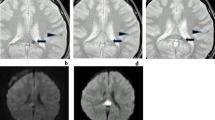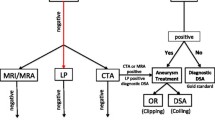Abstract
The specific appearance of blood related to time at T1- and T2-weighted spin-echo (SE) sequences is generally accepted; thus, these sequences are classically used for estimating the age of haematomas. Magnetic resonance imaging at 1.5 T, including T1- and T2-weighted SE fluid-attenuated inversion recovery (FLAIR) and T2*-weighted gradient-echo (GE) sequences, was performed on 82 intraparenchymal haematomas (IPHs) and 15 haemorrhagic infarcts (HIs) in order to analyse the appearance at different stages and with different sequences, and to investigate how reliably the age of hematomas can be estimated. The IPHs had been previously detected by CT, were spontaneous (n=72) or traumatic (n=10) in origin and were of different sizes (2 mm to 7 cm) and ages (from 7.5 h to 4 years after acute haemorrhagic event). The age of the lesion was calculated from the moment when clinical symptoms started or the traumatic event occurred. The 15 patients with HIs were patients with ischaemic stroke in whom there was either a suspicion of haemorrhagic transformation on CT, or haemorrhage was detected as an additional finding on MR performed for other indications. Patients with conditions that could affect the SI of blood, such as anticoagulant therapy or severe anaemia, were excluded. The signal intensity pattern of the lesions was analysed and related to their ages without prior knowledge of the clinical data. All lesions were detected with T2*-weighted GE. T1-weighted SE missed 13 haematomas and T2-weighted SE and FLAIR sequences missed five. Haemorrhagic transformation was missed in three infarcts by T1-, T2-weighted SE and FLAIR. The signal pattern on FLAIR was identical to that on T2-weighted SE. For all sequences, a wide variety of signal patterns, without a clear relationship to the age of the haematomas, was observed. There was a poor relationship between the real MR appearance of IPHs and the theoretical appearance on SE sequences. T2*-weighted GE was effective for detecting small bleedings but was not useful for estimating the age of a lesion. The FLAIR does not provide any more information than T2-weighted SE.








Similar content being viewed by others
References
Schellinger PD, Jansen O, Fiebach JB, Hacke W, Sartor K (1999) A standardized MRI stroke protocol: comparison with CT in hyperacute intracerebral hemorrhage. Stroke 30:765–768
Broderick J, Adams H, Barsam W et al. (1999) Guidelines for the management of spontaneous intracerebral hemorrhage. Stroke 30:905–915
Parizel PM, Makkat S, Van Miert E, Van Goethem JW, van den Hauwe L, De Schepper AM (2001) Intracranial haemorrhage: principles of CT and MR interpretation. Eur Radiol 11:1770–1783
Atlas SW, Thulborn KR (2002) Intracranial haemorrhage. In: Atlas SW (ed) Magnetic resonance imaging of the brain and spine. Lippincott, Williams and Wilkins, Philadelphia, pp 773–832
Linfante I, LLinas R, Caplan L, Warach S (1999) MRI features of intracerebral hemorrhage within 2 hours from symptom onset. Stroke 30:2263–2267
Patel MR, Edelman RR, Warach S (1996) Detection of hyperacute primary intraparenchymal hemorrhage by magnetic resonance imaging. Stroke 27:2321–2324
Wiesmann M, Mayer T, Yousry I, Hamann G, Bruckmann H (2001) Detection of hyperacute parenchymal hemorrhage of the brain using echo-planar T2*-weighted and diffusion-weighted MRI. Eur Radiol 11:849–853
Atlas SW, Mark AS, Grossman RI, Gomori JM (1988) Intracranial hemorrhage: gradient-echo MR imaging at 1.5 T. Comparison with spin-echo imaging and clinical applications. Radiology 168:803–807
Alemany M, Gustafsson O, Siösteen B, Olsson Y, Raininko R (2002) MRI follow-up of small experimental intracranial haemorrhages from hyperacute to subacute phase. Acta Radiol 43:2–9
Thulborn KR, Sorensen AG, Kowall NW, McKee A, Lai A, McKinstry RC, Moore J, Rosen BR, Brady TJ (1990) The role of ferritin and hemosiderin in the MR appearance of cerebral hemorrhage: a histopathologic biochemical study in rats. AJNR 11:291–297
Atlas SW, Thulborn KR (1998) MR detection of hyperacute parenchymal hemorrhage of the brain. AJNR 19:1471–1477
Alemany M, Siösteen B, Hartman M, Raininko R (2003) MR detectability and appearance of small experimental intracranial haematomas at 0.5T and 1.5T: a follow-up study for 6–7 months. Acta Radiol 44:199–205
Nighoghossian N, Hermier M, Adeleine P, Blanc-Lassere K, DerexL, Honnorat J (2002) Old microbleeds are a potential risk factor for cerebral bleeding after ischemic stroke. A gradient-echo T2*-weighted brain MR study. Stroke 33:735–742
Young IR, Khenia S, Thomas DG, Davis CH, Gadian DG, Cox IJ, Ross BD, Bydder GM (1987) Clinical magnetic susceptibility mapping of the brain. J Comput Assist Tomogr 11:2–6
Alemany M, Raininko R (2002) Experimental intracerebral and subarachnoid/intraventricular haemorrhages: MR detectability at 0.5T and 1.5T. Acta Radiol 43:464–473
Gustafsson O, Rossitti S, Ericsson A, Raininko R (1999) MR imaging of experimentally induced intracranial hemorrhage in rabbits during the first 6 hours. Acta Radiol 40:360–368
Boyko OB, Burger PC, Shelburne JD, Ingram P (1992) Non-heme mechanisms for T1 shortening: pathologic, CT and MR elucidation. AJNR 13:1439–1445
Castillo M, Scatliff JH, Kwock L, Green JJ, Suzuki K, Chancellor K, Smith JK (1996) Postmortem MR imaging of lobar cerebral infarction with pathologic and in vivo correlation. Radiographics 16:241–250
Valanne L, Paetau A, Suomalainen A, Ketonen L, Pihko H (1996) Laminar cortical necrosis in MELAS syndrome: MR and neuropathological observations. Neuropediatrics 27:154–60
Del Bigio MR, Yan HJ, Buist R, Peeling J (1996) Experimental intracerebral hemorrhage in rats. Magnetic resonance imaging and histopathological correlates. Stroke 27:2312–2320
Roob G, Schmidt R, Kapeller P, Lechner A, Hartung H, Fazekas F (1999) MRI evidence of past cerebral microbleeds in a healthy elderly population. Neurology 52:991–994
Bradley WG Jr (1993) MR appearance of hemorrhage in the brain. Radiology 189:15–26
Barkovich AJ, Atlas SW (1988) Magnetic resonance imaging of intracranial hemorrhage. Radiol Clin North Am 16:801–820
Brooks RA, Giro G di, Patronas N (1989) MR imaging of cerebral hematomas at different field strengths: theory and applications. J Comput Assist Tomogr 13:194–206
Gomori JM, Grossman RI (1987) Head and neck hemorrhage. In: Kresel HY (ed) Magnetic resonance annual 1987. Raven Press, New York, pp 71–112
Thulborn KR, Brady TJ (1989) Iron in magnetic resonance imaging of cerebral hemorrhage. Magn Reson Q 5:23–28
Brooks RA, Brunetti A, Alger JR, Giro G di (1989) On the origin of paramagnetic inhomogeneity effects in blood. Magn Reson Med 12:241–248
Bryant RG, Marill K, Blackmore C, Francis C (1990) Magnetic relaxation in blood and blood clots. Magn Reson Med 13:133–144
Gomori JM, Grossman RI, Goldberg HI, Zimmerman RA, Bilaniuk LT (1985) Intracranial hematomas: imaging by high-field MR. Radiology 157:87–93
Gomori J, Grossman R, Yu-Ip C, Asakura T (1987) NMR relaxation times of blood: dependence on field strength, oxidation state and cell integrity. J Comput Assist Tomogr 11:684–690
Hackney DB, Atlas SW, Grossman RI et al. (1987) Subacute intracranial hemorrhage: contribution of spin density to appearance on spin echo MR images. Radiology 165:199–202
Acknowledgements
This work was supported by grants from the Swedish Medical Research Council No K2001-73X-13188-03A, K2001-73X-13188-03B, K2001-73X-13158-04A and K2001-73X-13158–04B, the Stroke Fund and the Selander Foundation. We thank M. Koisti for his help with data analysis and L. Johansson for discussions.
Author information
Authors and Affiliations
Corresponding author
Additional information
This work was presented at the XXVIII ESNR congress, in Istanbul, Turkey, September 2003
Rights and permissions
About this article
Cite this article
Alemany Ripoll, M., Stenborg, A., Sonninen, P. et al. Detection and appearance of intraparenchymal haematomas of the brain at 1.5 T with spin-echo, FLAIR and GE sequences: poor relationship to the age of the haematoma. Neuroradiology 46, 435–443 (2004). https://doi.org/10.1007/s00234-004-1191-5
Received:
Accepted:
Published:
Issue Date:
DOI: https://doi.org/10.1007/s00234-004-1191-5




